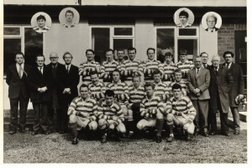
4. Club History
Although there are isolated references to matches in the 1880’s, the founding of the club was taken as 1888, from which date there is a complete factual record.
The club first played at Path Head on the outskirts of the town, but in 1892, it moved to the Blaydon Racecourse before transferring to The Spike.
During the next 25 years the ground moved between the two sites but after the First World War the Racecourse became the recognised ground with changing facilities housed in the Board Inn at Stella.
The club remained at the Racecourse until it was purchased by the then North Eastern Electricity Board in 1951 to erect Stella Power Station which of course is now demolished.
Upon leaving the Racecourse, the club moved to its present site “Crow Trees”at Swalwell and gradually over the succeeding years, the ground has been developed to include its state-of-the-art new clubhouse, stand, and two sets of match floodlights.
Immediately after the Second World War in season 1945/46, Blaydon were unbeaten and boasted amongst their players Martin Donnelly who became Blaydon’s first International Player when he played for England against Ireland in 1947. He also represented New Zealand many times at cricket, being one of the most cultured left-handed batsmen of his era.
The move to Crow Trees was inspired by President Bob Williams and long-serving Secretary of 50 years, Jack Brooks. Since this move to Crow Trees, the club has improved in stature, becoming a recognised force in North East rugby. The expansion of the ground saw floodlights erected in 1968 which were opened by Border club Hawick in front of a record 3,500 spectators. A further set of floodlights have been erected on the riverside pitch in 1995 and mainly through the efforts of Jim Huxley as Fixture Secretary for 33 years, prior to the advent of leagues, the club has expanded its horizons to its present position.
During this period of improvement in Blaydon’s fortunes, many local players made their mark amongst them Stephen Bainbridge and Michael Skinner who both played rugby many times for England. Other players who made notable contributions during this period were Bob Bartle, Russ Teasdale, Maurice Davidson, Michael Smith, Ian Parratt and the brothers Jim and David Knight to name but a few.
Whilst success continued steadily, the Durham County Cup always alluded Blaydon until 1996 when David Guthrie lifted the trophy after Blaydon had defeated Darlington 22 – 3 in the final. David was Captain of Blaydon for 15 seasons, a National League record and during his captaincy the club experienced a successful period in the League system being promoted four times and ending up in their current position in National League 1. BlaydonRFC played in ND1 for 9 seasons, being relegated at the end of 2016/17 Season.
Off the field, the club expanded and on 19th October 1996, the newly refurbished clubhouse was opened by Messrs Bainbridge and Skinner. The total cost of the project was 1.2 million pounds which was Lottery Grant aided. This clubhouse has three function suites and a magnificent gymnasium boasting over 1,000 members and with the weekly nationally known Car Boot Sale, Blaydon has been able to stabilize and plan its financial future.
Members of Blaydon Rugby Football Club are truly proud of these achievements and feel established in this level of rugby.

